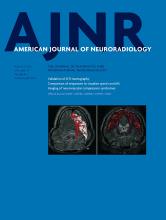Index by author
Dudink, J.
- Pediatric NeuroimagingYou have accessA New Ultrasound Marker for Bedside Monitoring of Preterm Brain GrowthJ.A. Roelants, I.V. Koning, M.M.A. Raets, S.P. Willemsen, M.H. Lequin, R.P.M. Steegers-Theunissen, I.K.M. Reiss, M.J. Vermeulen, P. Govaert and J. DudinkAmerican Journal of Neuroradiology August 2016, 37 (8) 1516-1522; DOI: https://doi.org/10.3174/ajnr.A4731
Eisenmenger, L.B.
- Extracranial VascularYou have accessPrediction of Carotid Intraplaque Hemorrhage Using Adventitial Calcification and Plaque Thickness on CTAL.B. Eisenmenger, B.W. Aldred, S.-E. Kim, G.J. Stoddard, A. de Havenon, G.S. Treiman, D.L. Parker and J.S. McNallyAmerican Journal of Neuroradiology August 2016, 37 (8) 1496-1503; DOI: https://doi.org/10.3174/ajnr.A4765
Ellingson, B.M.
- EDITOR'S CHOICEAdult BrainOpen AccessImproved Leakage Correction for Single-Echo Dynamic Susceptibility Contrast Perfusion MRI Estimates of Relative Cerebral Blood Volume in High-Grade Gliomas by Accounting for Bidirectional Contrast Agent ExchangeK. Leu, J.L. Boxerman, T.F. Cloughesy, A. Lai, P.L. Nghiemphu, L.M. Liau, W.B. Pope and B.M. EllingsonAmerican Journal of Neuroradiology August 2016, 37 (8) 1440-1446; DOI: https://doi.org/10.3174/ajnr.A4759
The authors' hypothesis is that incorporating bidirectional contrast agent transport into the DSC MR imaging signal model will improve rCBV estimates in brain tumors. A unidirectional contrast agent extravasation model (Boxerman-Weisskoff) was compared with a bidirectional contrast agent exchange model. For both models, they compared the goodness of fit with the parent leakage-contaminated relaxation rate curves and the difference between modeled interstitial relaxation rate curves and dynamic contrast-enhanced MR imaging in 21 patients with glioblastoma. The authors conclude that the bidirectional model more accurately corrects for the T1 or T2* enhancement arising from contrast agent extravasation due to blood-brain barrier disruption in high-grade gliomas by incorporating interstitial washout rates into the DSC MR imaging relaxation rate model.
Enokizono, M.
- Pediatric NeuroimagingYou have accessQuiet T1-Weighted Pointwise Encoding Time Reduction with Radial Acquisition for Assessing Myelination in the Pediatric BrainN. Aida, T. Niwa, Y. Fujii, K. Nozawa, M. Enokizono, K. Murata and T. ObataAmerican Journal of Neuroradiology August 2016, 37 (8) 1528-1534; DOI: https://doi.org/10.3174/ajnr.A4747
Etienne, L.
- Adult BrainOpen AccessImaging of Neurovascular Compression Syndromes: Trigeminal Neuralgia, Hemifacial Spasm, Vestibular Paroxysmia, and Glossopharyngeal NeuralgiaS. Haller, L. Etienne, E. Kövari, A.D. Varoquaux, H. Urbach and M. BeckerAmerican Journal of Neuroradiology August 2016, 37 (8) 1384-1392; DOI: https://doi.org/10.3174/ajnr.A4683
Fakhran, S.
- Spine Imaging and Spine Image-Guided InterventionsYou have accessEffect of the Suboccipital Musculature on Symptom Severity and Recovery after Mild Traumatic Brain InjuryS. Fakhran, C. Qu and L.M. AlhilaliAmerican Journal of Neuroradiology August 2016, 37 (8) 1556-1560; DOI: https://doi.org/10.3174/ajnr.A4730
Feinstein, A.
- EDITOR'S CHOICEAdult BrainOpen AccessCortical Perfusion Alteration in Normal-Appearing Gray Matter Is Most Sensitive to Disease Progression in Relapsing-Remitting Multiple SclerosisS.-P. Hojjat, M. Kincal, R. Vitorino, C.G. Cantrell, A. Feinstein, L. Zhang, L. Lee, P. O'Connor, T.J. Carroll and R.I. AvivAmerican Journal of Neuroradiology August 2016, 37 (8) 1454-1461; DOI: https://doi.org/10.3174/ajnr.A4737
Bookend perfusion was used to quantify parameters in normal-appearing and lesional tissue at different relapsing-remitting MS stages in 39 patients and 19 age-matched healthy controls. Perfusion parameters such as CBF, CBV, and MTT were compared along with cognitive performance. White matter lesion but not cortical lesion perfusion was significantly reduced in cognitively impaired patients with relapsing-remitting MS versus unimpaired patients with relapsing-remitting MS. Perfusion reduction with disease progression was greater in normal-appearing gray matter and normal-appearing white matter compared with cortical lesions and white matter lesions. The authors conclude that the greatest changes are present within NAGM and NAWM, necessitating absolute rather than relative lesion perfusion measurement.
Feng, L.-J.
- Adult BrainYou have accessGeometric Parameter Analysis of Ruptured and Unruptured Aneurysms in Patients with Symmetric Bilateral Intracranial Aneurysms: A Multicenter CT Angiography StudyZ.-Q. Huang, Z.-H. Meng, Z.-J. Hou, S.-Q. Huang, J.-N. Chen, H. Yu, L.-J. Feng, Q.-J. Wang, P.-A. Li and Z.-B. WenAmerican Journal of Neuroradiology August 2016, 37 (8) 1413-1417; DOI: https://doi.org/10.3174/ajnr.A4764
Foster, L.D.
- FELLOWS' JOURNAL CLUBAdult BrainOpen AccessMultimodal CT Imaging: Time to Treatment and Outcomes in the IMS III TrialA. Vagal, L.D. Foster, B. Menon, A. Livorine, J. Shi, E. Qazi, S.D. Yeatts, A.M. Demchuk, M.D. Hill, T.A. Tomsick and M. GoyalAmerican Journal of Neuroradiology August 2016, 37 (8) 1393-1398; DOI: https://doi.org/10.3174/ajnr.A4751
The authors explored the effect of multimodal imaging (CT perfusion and/or CT angiography) versus noncontrast CT alone on time to treatment and outcomes in the IMS III trial. Of 656 subjects enrolled in the trial, 90 (13.7%) received CTP and CTA, 216 (32.9%) received CTA (without CTP), and 342 (52.1%) received NCCT alone. Median times from stroke onset to IV tPA in the CTP+CTA, CTA, and NCCT groups were 120.5 vs 117.5 vs 120 minutes, respectively. They conclude that the use of CTA (with or without CTP) did not delay IV tPA or endovascular therapy compared with NCCT in the IMS III trial.
Franca, M.C.
- Adult BrainYou have accessMR Imaging in Spinocerebellar Ataxias: A Systematic ReviewA. Klaes, E. Reckziegel, M.C. Franca, T.J.R. Rezende, L.M. Vedolin, L.B. Jardim and J.A. SauteAmerican Journal of Neuroradiology August 2016, 37 (8) 1405-1412; DOI: https://doi.org/10.3174/ajnr.A4760








